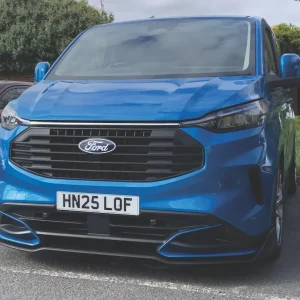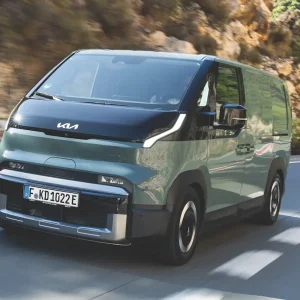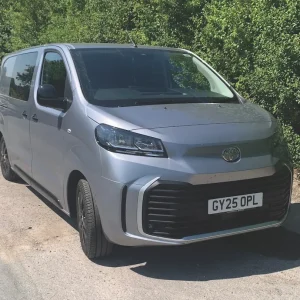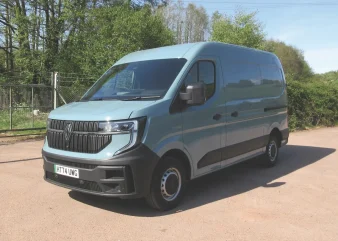
Electric vans have come a long way over the past seven years.
When a battery powered Renault Master was first introduced in 2018 under the Z.E banner, it came with a 33kWh battery giving it a meagre range of just 74 miles.
By contrast the latest Master E-Tech marketed in the UK today is equipped with an 87kWh battery delivering a claimed range of over 285 miles depending on the model variant.
At 105kW (143hp), the electric motor it feeds might be viewed as offering insufficient power compared with what is on offer from rival products. In response, Renault contends that the distinctive way in which the Master has been restyled means that it is 27% more power-efficient than its predecessor thanks to 20% better aerodynamics.
As a consequence, the motor delivers more punch in real terms than it appears to do on paper, the argument runs.
In other markets, the E-Tech is also sold with a 40kWh battery and a 96kW (129hp) motor – fine for short-haul urban runs, maybe, but with limited appeal to many British businesses one suspects.
The E-Tech is listed with one level of trim (Advance) and with two lengths and one roof height offering either 10.3m3 or 13m3 of load space. It can be ordered at either 3.5 or four tonnes.
We got to grips with the shorter and lighter of the two vehicles listed – an MM35 3.5-tonner.
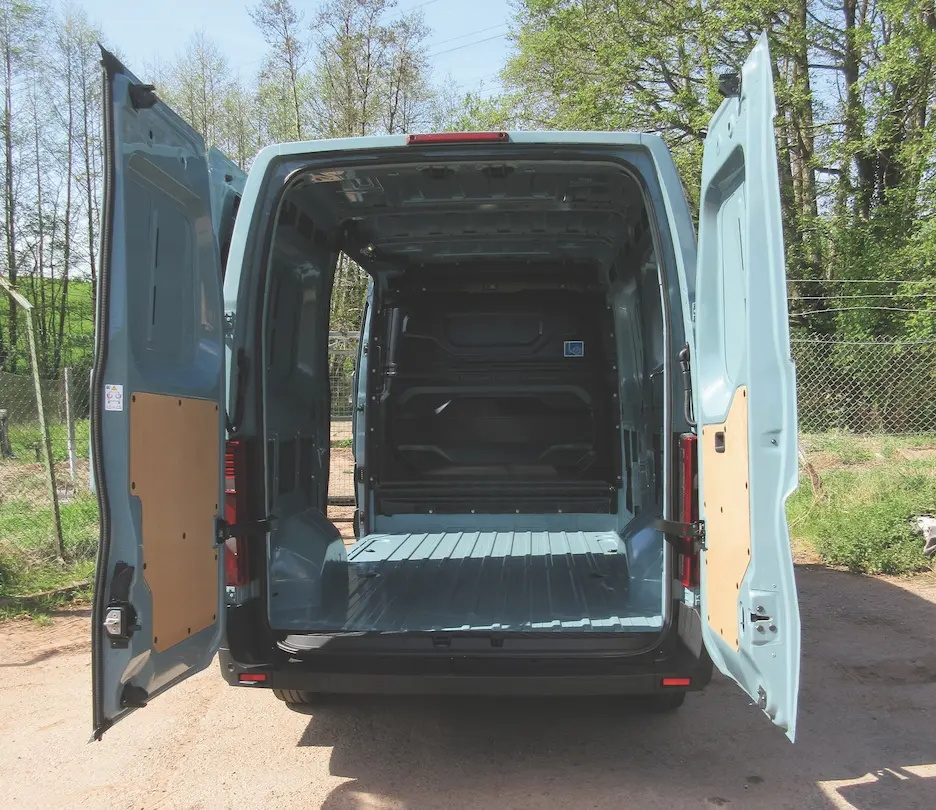
Load bay
Access to the 10.3m3 cargo area is through a sliding nearside door or by means of twin rear doors that can be swung through 90°, and through 180° if you release the stays. Grab handles adjacent to both the commendably large side and rear door apertures make climbing aboard a little easier, although the van’s front-wheel-drive configuration means that the height of the load bed from the ground is relatively modest.
A full-height steel bulkhead separates the cab from the load bay. The cargo bed features four load tie-down points, and you’ll find two more at the bottom of the bulkhead plus one at the base of each of the rear door pillars.
The nearside pillar also plays host to a 12V power socket.
Hardboard panels provided the doors on our demonstrator with some protection from dents and scrapes. The rest of the load area, including the floor, had no defence against minor damage, however, and needed timbering out.
The weight of the battery pack means that this Master E-Tech can only handle a modest 1,125kg payload. Braked trailer towing capacity is limited too, at 1,500kg.
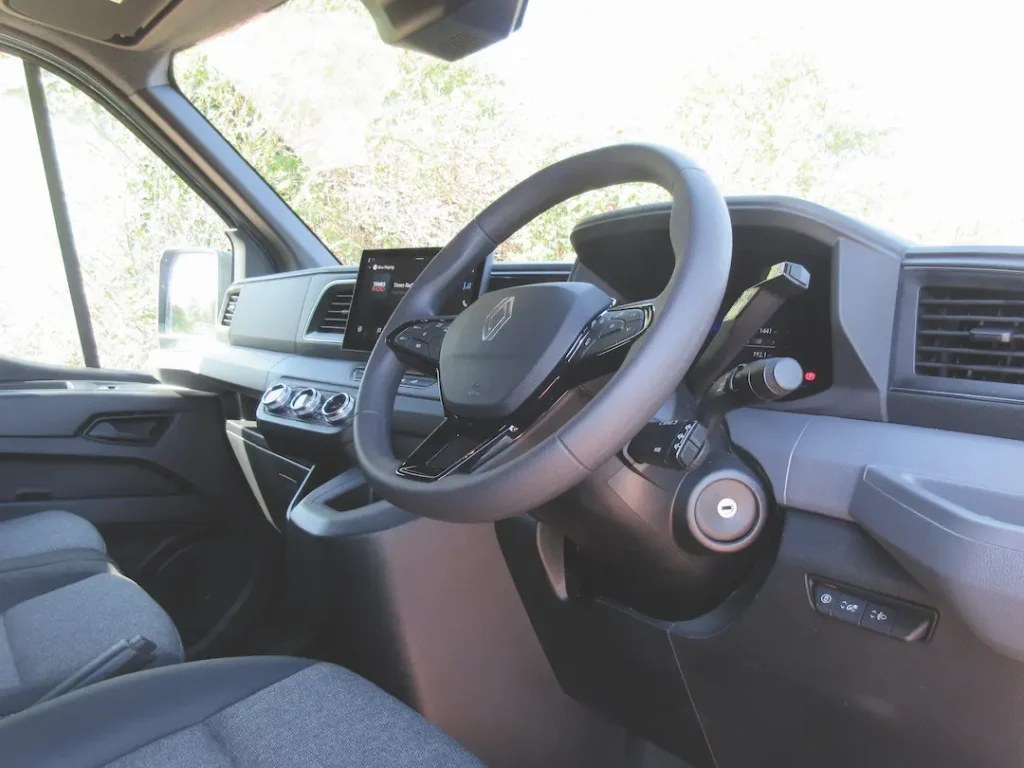
Interior and equipment
Renault’s new Master won the What Van? Van of the Year award for 2025, but that doesn’t mean it’s perfect. No van is.
We can’t quite figure out why the Master E-Tech has still got a manual handbrake lever when an electronic parking brake would make far more sense. The latter is due to appear this year, but should surely have been provided from the get-go.
Nor can we understand why the E-Tech still employs an ignition key given that electric vans don’t have an ignition system.
These quibbles aside, everything else seems straightforward enough.
A steering column stalk allows you to opt for drive, neutral or reverse, and a quick flick gives you regeneration when you slow, pumping kinetic energy which would otherwise be lost into the traction battery. Another column stalk lets you switch channels on the DAB radio and turn up the volume.
Drivers are faced by a 7in colour TFT (Thin Film Transistor) information display and can make use of a 10.1in OpenR Link touchscreen that enables Android Auto and Apple CarPlay connectivity.
Pay extra, and you can have Google built in with Google Maps, the Google Play app catalogue and a voice-controlled Google Assistant. An Electric Route Planner can locate charging stations.
We’re glad to see that the heating, ventilation and manual air-conditioning are controlled by big, chunky knobs on the dashboard. Few things are more irritating than having to keep stabbing at an unco-operative touchscreen simply because you want to turn the temperature up a notch.
Cruise control with a speed limiter is fitted along with electric windows and electrically adjustable, heated exterior mirrors, with the mirror casings incorporating separate, lower, wide-angle sections. A quick glance around the cab reveals the presence of two USB ports plus a 12V power socket while other useful features include driver, passenger and side airbags.
In-cab storage facilities in the three-seater cab include two large bins and two narrow shelves in each door. The door bins can be difficult to reach from the seats, and you can only get at them properly when the doors are open.
There are shelves above the windscreen – one on the driver’s side, one on the passenger side – with a slot between them that could accommodate a tachograph.
Three shelves of varying sizes are positioned on top of the dashboard while a fourth shelf sits above the lidded, but not lockable, glovebox. Another shelf sticks out of the dashboard, to the driver’s left.
Pull up the passenger seat cushions, and you reveal a concealed space that you can use to hide a tablet, power tools and other valuable items that you’d rather not lose to the light-fingered.
If you’ve just concluded that there is no lack of storage space, then you would be right. Renault says it totals 135 litres, 25% more than the previous Master.
A cupholder sits at each extremity of the fascia and can apparently be used as a grab-handle to help you haul yourself aboard. There is a grab-handle above the passenger door too, but not above the driver’s door; a quirk of the conversion from left to right-hand drive, we suspect.
The driver’s seat and steering wheel are both height-adjustable – the seat includes an armrest and lumbar adjustment – so you can achieve a comfortable driving position once you’ve settled down behind the wheel.
The passenger sitting on the middle seat is going to be less fortunate, alas. They will find leg room is limited, and are likely to feel that the centre perch is only really suitable for short journeys.The middle seat has one virtue, however. The seat back incorporates a desk which can be folded forwards for the driver to use.
Disc brakes are fitted all round and onboard safety systems aside from ABS include active emergency braking with pedestrian and cyclist detection, lane keep assist and intelligent speed assist with overspeed prevention and traffic sign recognition. The last-named gizmo tells you the speed you should be doing down a particular stretch of road, and was often inaccurate, but the Master E-Tech is by no means unique in this regard.
Rear parking sensors are fitted, but there’s no reversing camera. We reckon it should be standard on large panel vans given that it is impossible for drivers to see what is directly behind them without one.
The turning circle between kerbs is 12.8m increasing to 13.4m between walls, and the Master E-Tech is pretty manoeuvrable in busy city centres. Our van’s 16in steel wheels were shod with 205/75 R16C Continental VanContact Eco tyres watched over by a pressure monitoring system.
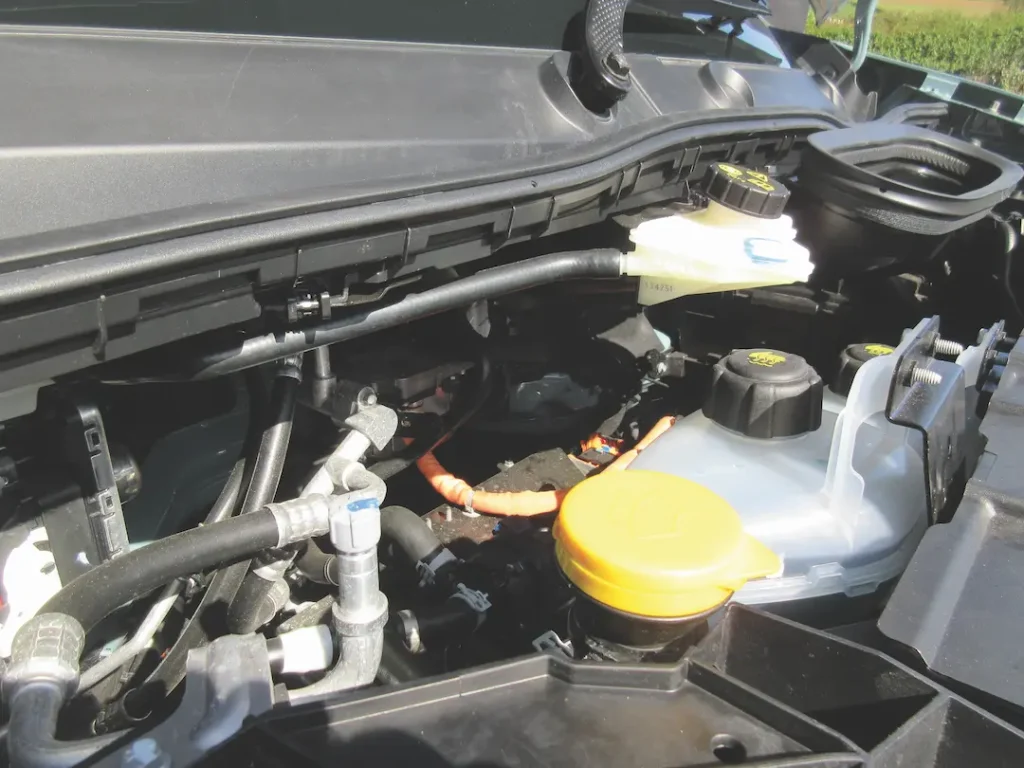
Powertrain
Married to a single-speed transmission, the 105kW motor delivers 300Nm of torque.
If you are using a 7.4 kW AC home wall box then you should be able to boost the battery’s charge from zero to maximum in just under 14 hours says Renault. Hook it up to a 150kW DC fast-charger and it should take you no more than 70 minutes, it adds.
Driving
The Master E-Tech handles remarkably well, with none of the lurching and swaying you can sometimes get with a largish panel van when you tackle a bend. It feels firmly planted on the highway and that breeds confidence, although hopefully not over-confidence.
As we pointed out earlier, the motor’s power output is not enormous, yet there is no lack of performance. Press the ECO button on the dashboard and it diminishes because power is reduced by 30% to help preserve the range, but the in-cab heater is not affected in the way it can be with other electric vans we have encountered.
While the ride cannot be classed as outstanding, it’s passable. You get a little wind and road noise and some muted whining from the electric motor, but all-in-all the driving experience is a pleasant one.
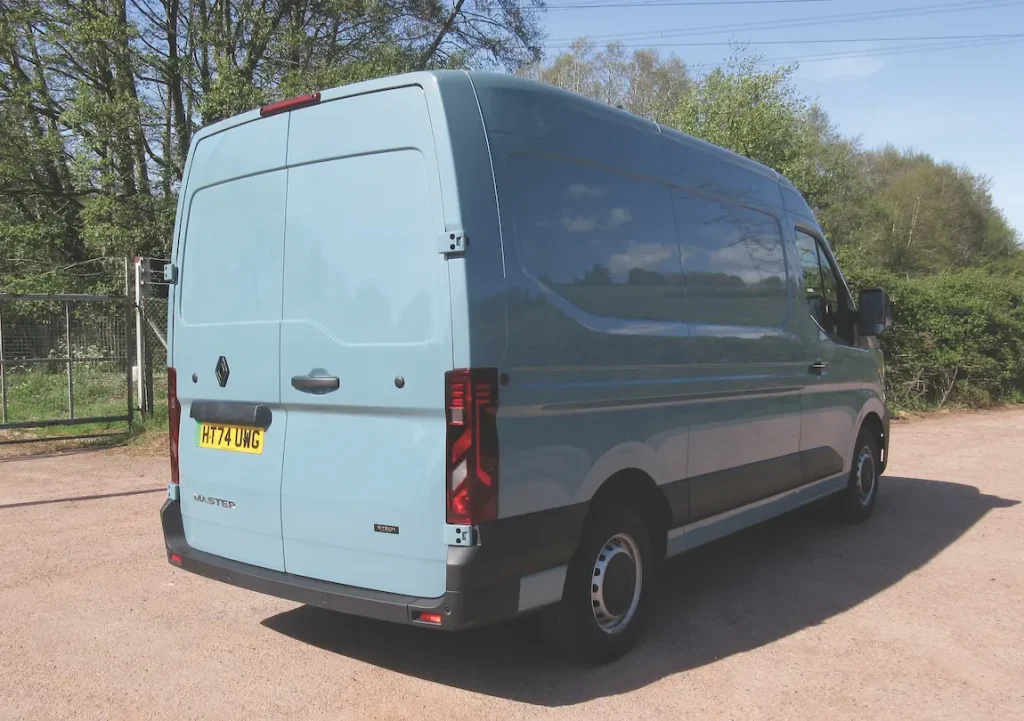
Operating
Service intervals are set at one year/12,000 miles. A three-year/unlimited-mileage warranty is provided while an eight-year/100,000-mile warranty covers the battery.
Side rubbing strips protect the bodywork against minor damage – just as well given that our demonstrator’s optional Agave Blue paint finish costs £650.
No spare wheel is provided, presumably in a bid to achieve a weight saving, and you will find a tyre inflator/sealer under the driver’s seat instead. This is fine if a tyre suffers a minor puncture, maybe, but useless if it is severely gashed by one of the massive potholes that pepper the country’s poorly maintained highways.
Don’t forget that the Master E-Tech is also sold by Renault Trucks – a route worth considering if your business requires 24/7 truck dealer-style back-up – and by Nissan with an Interstar badge.
| Model | Renault Master MM35 Advance E-Tech |
| Price (ex VAT and PIVG) | £42,500 |
| Price range (ex VAT and PIVG) | £42,500–£46,250 |
| Gross payload | 1,125kg |
| Load length | 3,225mm |
| Load width (min/max) | 1,380mm/1,789mm |
| Load bay height | 1,885mm |
| Load volume | 10.3m3 |
| Loading height | 569mm |
| Rear door aperture | 1,754mm x 1,537mm |
| Side door aperture | 1,753mm x 1,350mm |
| Gross vehicle weight | 3,500kg |
| Braked trailer towing weight | 1,500kg |
| Engine size/power | 105kW (143hp) electric motor |
| Torque | 300Nm |
| Gearbox | 1sp |
| Range (combined WLTP) | 255 miles |
| Battery | 87kWh |
| CO2 | 0g/km |
| Warranty | 3yrs/100,000 miles (battery 8yrs/100,000 miles) |
| Service intervals | 1yr/12,000 miles |
| Insurance group | TBA |
| Price as tested | £43,150 |
| Options | Agave Blue paint (£650) |
Rivals
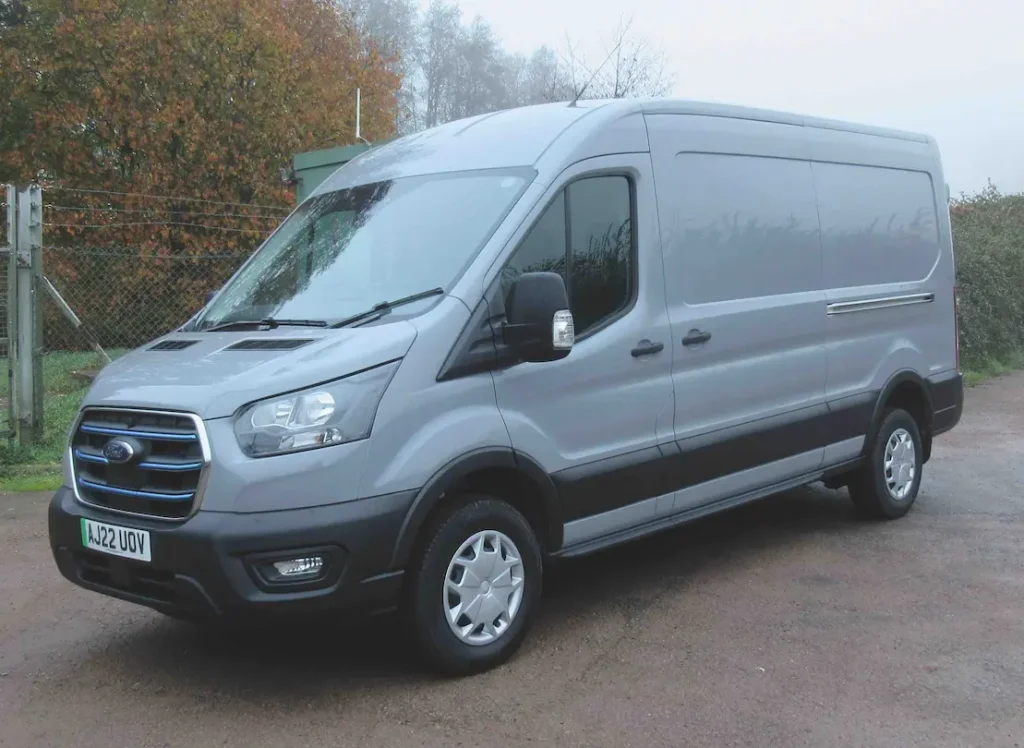
Ford E-Transit
Ford has proved unbeatable in the van market for as long as anybody can remember, and while the E-Transit isn’t perfect, it’s sure to keep garnering fleet sales. Two different motors are listed, with no shortage of torque, and the wide variety of electric vans, double-cab-in-vans and chassis cabs that customers can choose from is undoubtedly impressive. Residual values are unlikely to be too much of an issue and you’re never too far from a Ford dealer.
| Price range (ex VAT and PIVG) | £49,545–£63,635 |
| Load volume | 9.5-15.1m3 |
| Gross payload | 790-1,758kg |
| Electric motor | 135kW, 198kW |
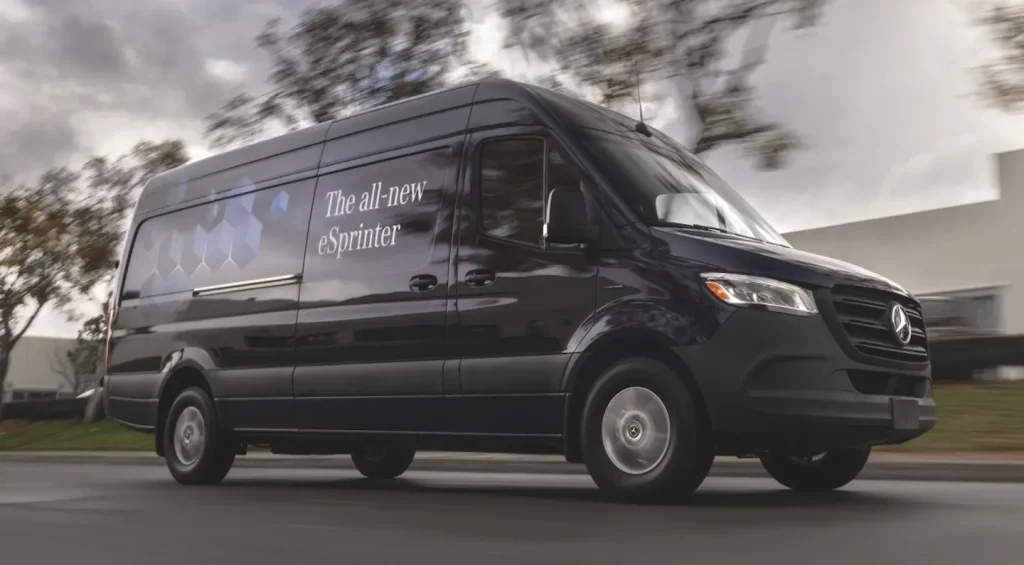
Mercedes-Benz eSprinter
Mercedes has made big strides with the eSprinter, and the latest version offers a much better range than its inadequate predecessor. The line-up embraces two battery sizes, two different motor power outputs, three driving modes and a regeneration system that employs steering wheel paddles. Payload capacities are unimpressive though, and the eSprinter is expensive.
| Price range (ex VAT and PIVG) | £59,915–£76,920 |
| Load volume | 9-14m3 |
| Gross payload | 490–1,273kg |
| Electric motor | 100kW, 150kW |
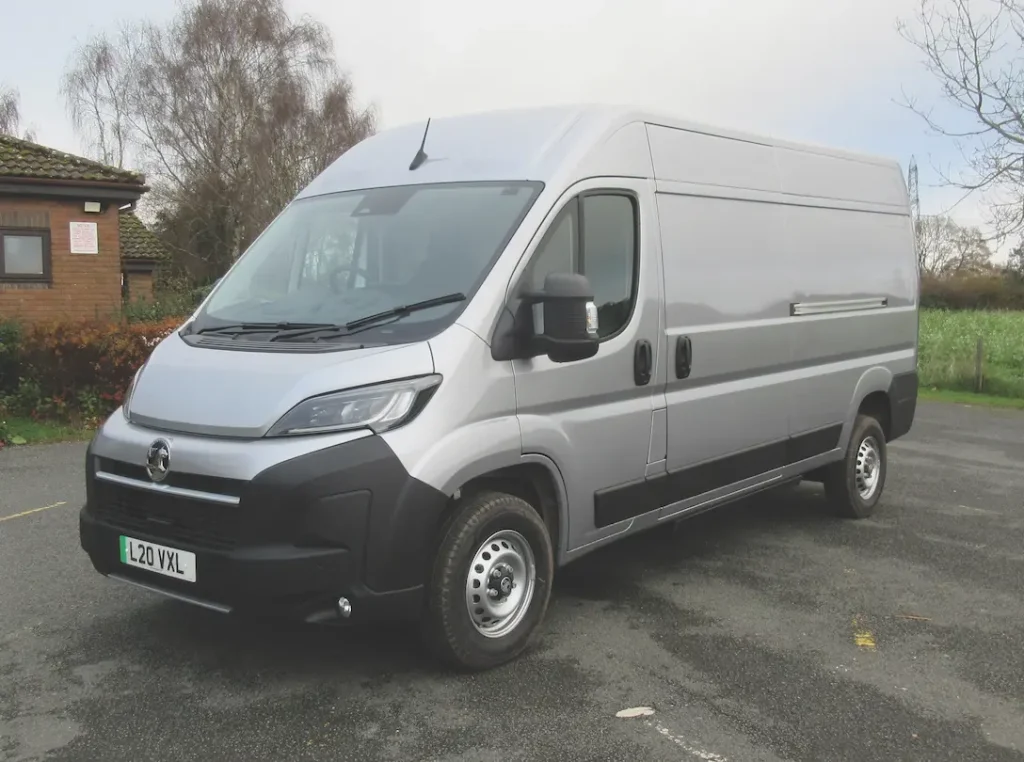
Vauxhall Movano Electric
Has one or two drawbacks, but on balance not too bad a package. Bear in mind that Vauxhall is owned by global automotive giant Stellantis, and that as a consequence the same van is also available with Citroen, Peugeot and Fiat Professional badges. It is also marketed as a Toyota, thanks to a deal done between Stellantis and the Japanese manufacturer. Like Renault, Stellantis has been developing hydrogen fuel cell models – although it recently announced a move away from the technology – and a Movano incorporating a fuel cell features in Vauxhall’s price list. Not cheap though.
| Price range (ex VAT and PIVG) | £50,385–£52,815 |
| Load volume | 13–17m3 |
| Gross payload | 710–1,460kg |
| Electric motor | 205kW |
The Final Verdict
| Design | 8/10 | Odd mixture of old and new (why retain an ignition key?) yet it all seems to hang together. |
| Cabin | 8/10 | Comfortable working environment with ample storage space, although not all of the compartments are easy to access. |
| Ride | 7/10 | Passable, but couldn’t be classed as outstanding. |
| Refinement | 8/10 | Quiet, aside from some wind and road noise, with no squeaking or creaking. |
| Load area | 7/10 | Does what it says on the tin, but in our case needed timbering out. Load capacity is modest so you may want to step up to the four-tonner. |
| Handling/performance | 8/10 | Former is exemplary, latter is more impressive than the figures on paper might suggest. |
| Motor/transmission | 8/10 | Both deliver, more so than might be expected. |
| Standard equipment | 7/10 | A bit more kit wouldn’t hurt, including a reversing camera given the opacity of the bulkhead and rear doors. |
| Operating costs | 9/10 | Competitive front-end price is worthy of a round of applause and the energy and maintenance bills you have to shoulder shouldn’t break the bank. |
| What Van? subjective rating | 9/10 | One of the most impressive electric vans we’ve encountered helping to make the Master a worthy winner of our 2025 Van of the Year accolade. |
| Overall rating | 79/100 |

